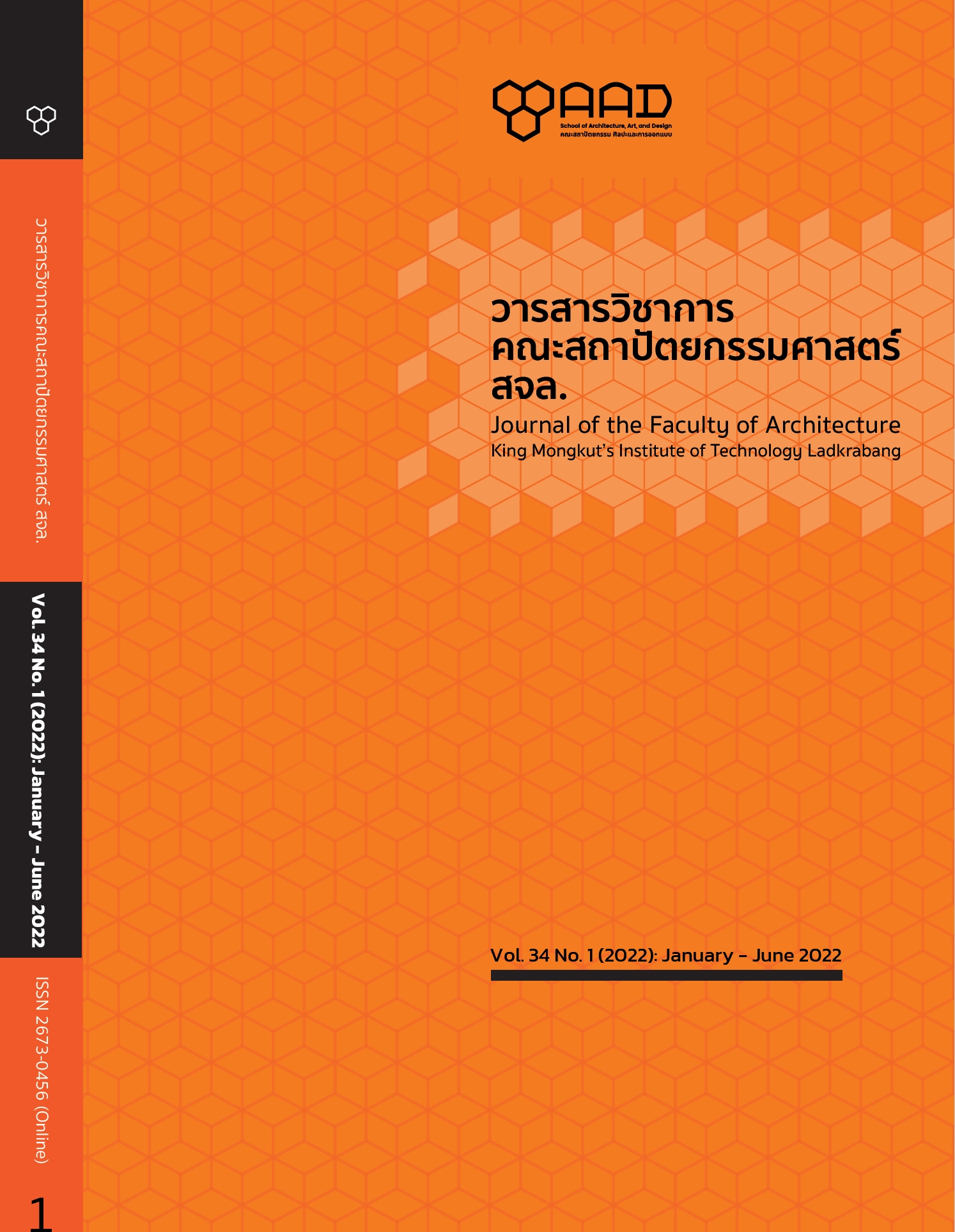A study of Cognitive Domains on Cooperative and Collaborative Learning A case of exhibition and museum design course
Main Article Content
Abstract
The objectives of this research were 1) to develop the teaching and learning process according to the collaborative learning strategy of cooperative and collaborative learning through projects of undergraduate students in the Exhibition and Museum Design Course 2) to study the learning achievements of the exhibition and museum design course with a cooperative and collaborative learning strategy with collaborative learning through project works of undergraduate students by giving learners an average academic achievement score of not less than 75% 3) to study student satisfaction through a cooperative and collaborative learning strategy with collaborative learning through the project results of undergraduate students by giving students a level of satisfaction of not less than 3.5. 4) assessed students' satisfaction in the exhibition and museum design courses. Forty-nine samples included in this research were undergraduate students of the researcher’s workplace, the first semester of 2020 with purposive sampling. The research tools were 1) a lesson plan for exhibition and museum design courses that organized cooperative and collaborative learning activities through 4 project works, 2) scoring rubric with evaluating form, 3) cognitive learning achievement score form, 4) satisfaction assessment form. The research results found that 1) the effects of cooperative and collaborative learning activities through project resulted in students' understanding, analytical thinking, and ability to solve the problem. This data created a body of knowledge and influenced the teachers to know the issues, challenges in teaching and learning, and solutions. 2) the evaluation results of the cooperative and collaborative learning activities through the project revealed that the learners could do projects according to their interests, stimulating interest, and taking action on their own. They were creating more experiences and knowledge from researching information from different sources, discussing knowledge together in groups, and presenting the project results came with an increase in the improvement score. 3) The excellent learning achievement scores from the four cooperative and collaborative learning activities projects were 83, 89, 91, 99, respectively, and the multiple-choice learning achievement in content was over 80%. 4) The overall satisfaction score of the students through cooperative and collaborative learning through the project work was at a high level, the score of 4.38. Most of the students have continually developed group work skills. There has been a change in behavior in a better direction. Including having a good group working attitude by increasing; as a result, students are satisfied with teaching and learning and have good grades by using cooperative and collaborative learning method.
Article Details

This work is licensed under a Creative Commons Attribution-NonCommercial-NoDerivatives 4.0 International License.
This work is licensed under a Creative Commons Attribution-NonCommercial-ShareAlike 4.0 International License.
Copyright Transfer Statement
The copyright of this article is transferred to Journal of The Faculty of Architecture King Mongkut's Institute of Technology Ladkrabang with effect if and when the article is accepted for publication. The copyright transfer covers the exclusive right to reproduce and distribute the article, including reprints, translations, photographic reproductions, electronic form (offline, online) or any other reproductions of similar nature.
The author warrants that this contribution is original and that he/she has full power to make this grant. The author signs for and accepts responsibility for releasing this material on behalf of any and all co-authors.
References
กัมปนาท คูศิริรัตน์, นุชรัตน์ นุชประยูร และเธียรธาดา หิรัญญะ ชาติธาดา. (2562). การจัดกิจกรรมการเรียนรู้แบบโครงงานเป็นฐาน เพื่อบูรณาการชิ้นงานรายวิชาคู่ขนานของนักศึกษาระดับปริญญาตรี. วารสารบัณฑิตศึกษา มหาวิทยาลัยราชภัฏวไลยอลงกรณ์ ในพระบรมราชูปถัมภ์. 13(2), 14-29.
เขมณัฏฐ์ มงศิริธรรม. (2554). การบูรณาการวิธีการเรียนแบบร่วมมือกับการเรียนร่วมกัน. วารสารกลุ่มมนุษยศาสตร์และสังคมศาสตร์. Veridian E-Journal SU. 4(1), 435-444.
ทิศนา แขมมณี. (2550). รูปแบบการเรียนการสอน: ทางเลือกที่หลากหลาย. พิมพ์ครั้งที่ 4. กรุงเทพฯ: สำนักพิมพ์แห่งจุฬาลงกรณ์มหาวิทยาลัย.
เทพกัญญา พรหมขัติแก้ว. (2557). ความรู้เบื้องต้นเกี่ยวกับการจัดการเรียนรู้แบบโครงงาน (Project-Based Learning). เข้าถึงได้จาก: http://physics.ipst.ac.th/wpcontent/uploads/sites/2/2015/05/IPST_Mag188_ProjectBased.pdf.
พรพร โยธาวงษ์. (2561). ผลสัมฤทธิ์จากการเรียนแบบห้องเรียนกลับด้านร่วมกับการสอนแบบบรรยายในวิชาการจัดการฟาร์มของนักศึกษาระดับปริญญาตรีสาขาวิชาการจัดการเทคโนโลยีฟาร์ม. Panyapiwat Journal. 10, 252-261.
พิมพ์ลดา กมลศิริธนพงษ์, นาตยา ปิลันธนานนท์ และศุภฤกษ์ ทานาค. (2561). การพัฒนาสัมฤทธิ์ผลการเรียนรู้ทักษะและเจตคติ การทำงานกลุ่มของนักเรียนชั้นมัธยมศึกษาที่ 1 โรงเรียนรัตนโกสินทร์สมโภชบางขุนเทียนโดยใช้การเรียนแบบร่วมมือในรายวิชาสร้างสรรค์งานกระดาษกลุ่มสาระการเรียนรู้การงานอาชีพและเทคโนโลยี. วารสารศึกษาศาสตร์ปริทัศน์. 33(1), 167-177.
รัตนาภรณ์ ทรงนภาวุฒิกุล. (2560). การวัดและประเมินผลการเรียนรู้ด้วยการให้คะแนนแบบรูบริค: Scoring Rubrics. Chandrakasem Rajabhat University Journal of Graduate School. 12(1), 1-14.
ลริตา บุญทศ และศิริพงษ์ เพียศิริ. (2558). การศึกษาผลสัมฤทธิ์ทางการเรียนและความสามารถในการประกอบอาหารประจำชาติอาเซียนของนักเรียนชั้นมัธยมศึกษาปีที่ 1 โดยการจัดการเรียนรู้แบบโครงงาน. Journal of Education Khon Kaen University (Graduate Studies Research). 9(1), 95-102.
วัชรา เล่าเรียนดี. (2550). เทคนิคและยุทธวิธีพัฒนาทักษะการคิด การจัดการเรียนรู้ที่เน้นผู้เรียนเป็นสำคัญ. นครปฐม: คณะศึกษาศาสตร์ มหาวิทยาลัยศิลปากร.
วิจิตรา ผาผึ้ง. (2556). การเปรียบเทียบผลสัมฤทธิ์ทางการเรียนความสามารถในการแก้ปัญหาและการถ่ายโยงการเรียนรู้โดย ใช้โปรแกรมบทเรียนแบบบูรณาการกับการเรียนปกติเรื่องการสร้างเว็บเพจของนักศึกษาระดับประกาศนียบัตร วิชาชีพชั้นปีที่ 2 สาขาคอมพิวเตอร์ธุรกิจ. Chophayom Journal. 24, 43-60.
สถาบันเทคโนโลยีพระจอมเกล้าเจ้าคุณทหารลาดกระบัง. (2560). หลักสูตรสถาปัตยกรรมศาสตรบัณฑิต สาขาวิชาสถาปัตยกรรมภายใน (หลักสูตรปรับปรุง พ.ศ. 2560) สถาบันเทคโนโลยีพระจอมเกล้าเจ้าคุณทหารลาดกระบัง. เข้าถึงได้จาก: https://www.arch.kmitl.ac.th/interior/b-inte.
Brookhart, S. M. (2013). How to Create and Use Rubrics for Formative Assessment and Grading. Alexandria, VA: ASCD, 2013.
Davidson, N., Major, C. H. and Michaelsen, L. K. (2014). Small-group learning in higher education—cooperative, collaborative, problem-based, and team-based learning: an introduction by the guest editors. Journal on Excellence in College Teaching. 25(3&4), 1-6.
Joyce, B & Weil, M. (1996). Models of Teaching. 3rd ed. Englewood Cliffs, N.J.: Prentice-Hall.
Krajcovicova, B. and Capay, M. (2012). Project based education of computer science using cross-curricular relations. Procedia-Social and Behavioral Sciences. 47, 54-61.
Sharan, Y., & Sharan, S. (1990). Group investigation expands cooperative learning. Educational leadership. 47(4), 17-21.


